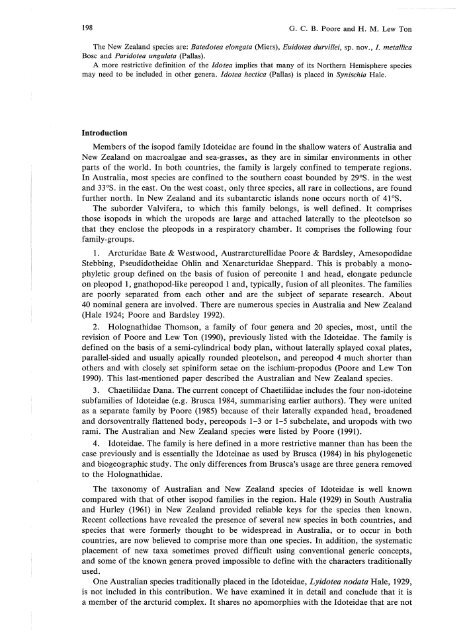Idoteidae of Australia and New Zealand (Crustacea: Isopoda: Valvif ...
Idoteidae of Australia and New Zealand (Crustacea: Isopoda: Valvif ...
Idoteidae of Australia and New Zealand (Crustacea: Isopoda: Valvif ...
Create successful ePaper yourself
Turn your PDF publications into a flip-book with our unique Google optimized e-Paper software.
198 G. C. B. Poore <strong>and</strong> H. M. Lew Ton<br />
The <strong>New</strong> Zeal<strong>and</strong> species are: Batedotea elongata (Miers), Euidotea durvillei, sp. nov., /. metallica<br />
Bosc <strong>and</strong> Paridotea ungulata (Pallas).<br />
A more restrictive definition <strong>of</strong> the Idotea implies that many <strong>of</strong> its Northern Hemisphere species<br />
may need to be included in other genera. Idotea hectica (Pallas) is placed in Synischia Hale.<br />
Introduction<br />
Members <strong>of</strong> the isopod family <strong>Idoteidae</strong> are found in the shallow waters <strong>of</strong> <strong>Australia</strong> <strong>and</strong><br />
<strong>New</strong> Zeal<strong>and</strong> on macroalgae <strong>and</strong> sea-grasses, as they are in similar environments in other<br />
parts <strong>of</strong> the world. In both countries, the family is largely confined to temperate regions.<br />
In <strong>Australia</strong>, most species are confined to the southern coast bounded by 29°S. in the west<br />
<strong>and</strong> 33°S. in the east. On the west coast, only three species, all rare in collections, are found<br />
further north. In <strong>New</strong> Zeal<strong>and</strong> <strong>and</strong> its subantarctic isl<strong>and</strong>s none occurs north <strong>of</strong> 41°S.<br />
The suborder <strong>Valvif</strong>era, to which this family belongs, is well defined. It comprises<br />
those isopods in which the uropods are large <strong>and</strong> attached laterally to the pleotelson so<br />
that they enclose the pleopods in a respiratory chamber. It comprises the following four<br />
family-groups.<br />
1. Arcturidae Bate & Westwood, Austrarcturellidae Poore & Bardsley, Amesopodidae<br />
Stebbing, Pseudidotheidae Ohlin <strong>and</strong> Xenarcturidae Sheppard. This is probably a monophyletic<br />
group defined on the basis <strong>of</strong> fusion <strong>of</strong> pereonite 1 <strong>and</strong> head, elongate peduncle<br />
on pleopod 1, gnathopod-like pereopod 1 <strong>and</strong>, typically, fusion <strong>of</strong> all pleonites. The families<br />
are poorly separated from each other <strong>and</strong> are the subject <strong>of</strong> separate research. About<br />
40 nominal genera are involved. There are numerous species in <strong>Australia</strong> <strong>and</strong> <strong>New</strong> Zeal<strong>and</strong><br />
(Hale 1924; Poore <strong>and</strong> Bardsley 1992).<br />
2. Holognathidae Thomson, a family <strong>of</strong> four genera <strong>and</strong> 20 species, most, until the<br />
revision <strong>of</strong> Poore <strong>and</strong> Lew Ton (1990), previously listed with the <strong>Idoteidae</strong>. The family is<br />
defined on the basis <strong>of</strong> a semi-cylindrical body plan, without laterally splayed coxal plates,<br />
parallel-sided <strong>and</strong> usually apically rounded pleotelson, <strong>and</strong> pereopod 4 much shorter than<br />
others <strong>and</strong> with closely set spiniform setae on the ischium-propodus (Poore <strong>and</strong> Lew Ton<br />
1990). This last-mentioned paper described the <strong>Australia</strong>n <strong>and</strong> <strong>New</strong> Zeal<strong>and</strong> species.<br />
3. Chaetiliidae Dana. The current concept <strong>of</strong> Chaetiliidae includes the four non-idoteine<br />
subfamilies <strong>of</strong> <strong>Idoteidae</strong> (e.g. Brusca 1984, summarising earlier authors). They were united<br />
as a separate family by Poore (1985) because <strong>of</strong> their laterally exp<strong>and</strong>ed head, broadened<br />
<strong>and</strong> dorsoventrally flattened body, pereopods 1-3 or 1-5 subchelate, <strong>and</strong> uropods with two<br />
rami. The <strong>Australia</strong>n <strong>and</strong> <strong>New</strong> Zeal<strong>and</strong> species were listed by Poore (1991).<br />
4. <strong>Idoteidae</strong>. The family is here defined in a more restrictive manner than has been the<br />
case previously <strong>and</strong> is essentially the Idoteinae as used by Brusca (1984) in his phylogenetic<br />
<strong>and</strong> biogeographic study. The only differences from Brusca's usage are three genera removed<br />
to the Holognathidae.<br />
The taxonomy <strong>of</strong> <strong>Australia</strong>n <strong>and</strong> <strong>New</strong> Zeal<strong>and</strong> species <strong>of</strong> <strong>Idoteidae</strong> is well known<br />
compared with that <strong>of</strong> other isopod families in the region. Hale (1929) in South <strong>Australia</strong><br />
<strong>and</strong> Hurley (1961) in <strong>New</strong> Zeal<strong>and</strong> provided reliable keys for the species then known.<br />
Recent collections have revealed the presence <strong>of</strong> several new species in both countries, <strong>and</strong><br />
species that were formerly thought to be widespread in <strong>Australia</strong>, or to occur in both<br />
countries, are now believed to comprise more than one species. In addition, the systematic<br />
placement <strong>of</strong> new taxa sometimes proved difficult using conventional generic concepts,<br />
<strong>and</strong> some <strong>of</strong> the known genera proved impossible to define with the characters traditionally<br />
used.<br />
One <strong>Australia</strong>n species traditionally placed in the <strong>Idoteidae</strong>, Lyidotea nodata Hale, 1929,<br />
is not included in this contribution. We have examined it in detail <strong>and</strong> conclude that it is<br />
a member <strong>of</strong> the arcturid complex. It shares no apomorphies with the <strong>Idoteidae</strong> that are not
















